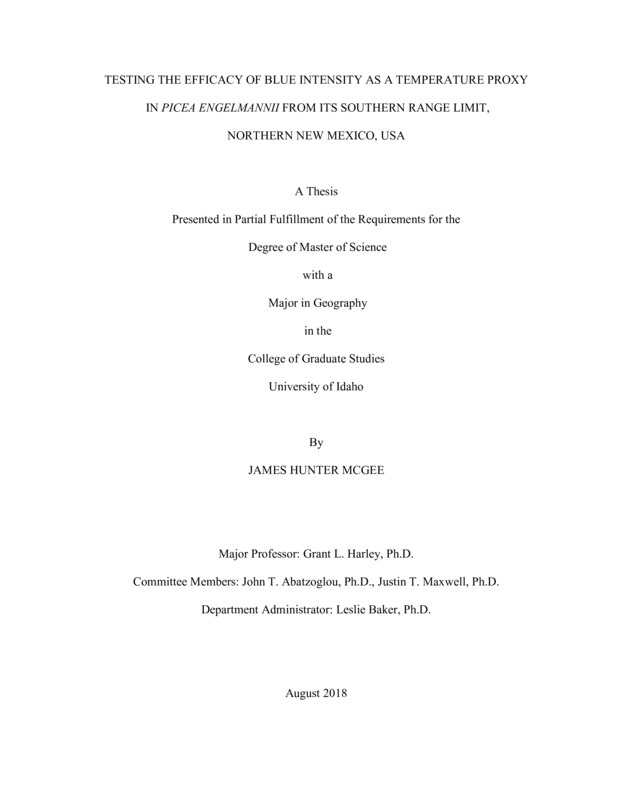TESTING THE EFFICACY OF BLUE INTENSITY AS A TEMPERATURE PROXY IN PICEA ENGELMANNII FROM ITS SOUTHERN RANGE LIMIT, NORTHERN NEW MEXICO, USA
McGee, James H.. (2018-08). TESTING THE EFFICACY OF BLUE INTENSITY AS A TEMPERATURE PROXY IN PICEA ENGELMANNII FROM ITS SOUTHERN RANGE LIMIT, NORTHERN NEW MEXICO, USA. Theses and Dissertations Collection, University of Idaho Library Digital Collections. https://www.lib.uidaho.edu/digital/etd/items/mcgee_idaho_0089n_11448.html
- Title:
- TESTING THE EFFICACY OF BLUE INTENSITY AS A TEMPERATURE PROXY IN PICEA ENGELMANNII FROM ITS SOUTHERN RANGE LIMIT, NORTHERN NEW MEXICO, USA
- Author:
- McGee, James H.
- ORCID:
- 0000-0002-5590-9903
- Date:
- 2018-08
- Keywords:
- Blue intensity CooRecorder Dendrochronology Dendroclimatology Engelmann spruce Temperature proxy
- Program:
- Geography
- Subject Category:
- Geography
- Abstract:
-
Annually resolved temperature proxies are rare for the American Southwest. Recent studies involving the analysis of blue light intensity consistently show an inverse show in inverse relationship between maximum latewood density and blue intensity values. Blue intensity analysis records the amount of blue light absorbed by tracheid cells, thereby quantifying the amount of lignin present in the latewood of the annual rings. This study aims to fill the gap of historical temperature data for the southern range limit of the Sangre de Cristo Mountains of northern New Mexico using annual climate data and blue light intensity analysis of tree rings as a proxy for maximum latewood density analysis. This is done using 27 high-elevation Engelmann spruce (Picea engelmannii Parry ex Engelmann) samples collected from 16 trees located at Wheeler Peak, New Mexico. We also include a test of the efficacy of generating BI data with the CooRecorder density software package. Samples are also measured for minimum earlywood and latewood density, and change in blue intensity values (delta). Results of this study suggest that a statistically significant relationship exists between blue intensity values and maximum annual summer temperature. A warming trend is evident at the turn of the 21st century when observing the delta blue intensity time series data, which is also present in PRISM instrumental temperature data used. Additional research utilizing the methods described in this study can be conducted at similar sites located at high latitudes and alpine environments. Furthermore, a study comparing trends in blue intensity parameters across multiple sites would be valuable. This study contributes to the increased understanding of how blue light intensity can be used as a new and innovative tool within the field of dendroclimatology.
- Description:
- masters, M.S., Geography -- University of Idaho - College of Graduate Studies, 2018-08
- Major Professor:
- Harley, Grant L.
- Committee:
- Abatzoglou, John T.; Maxwell, Justin T.
- Defense Date:
- 2018-08
- Identifier:
- McGee_idaho_0089N_11448
- Type:
- Text
- Format Original:
- Format:
- application/pdf
- Rights:
- In Copyright - Educational Use Permitted. For more information, please contact University of Idaho Library Special Collections and Archives Department at libspec@uidaho.edu.
- Standardized Rights:
- http://rightsstatements.org/vocab/InC-EDU/1.0/

